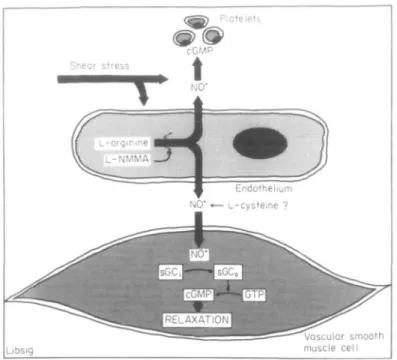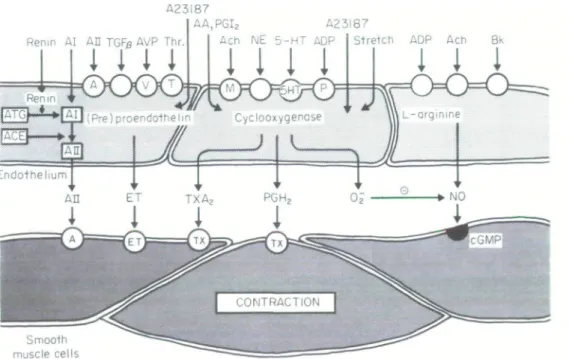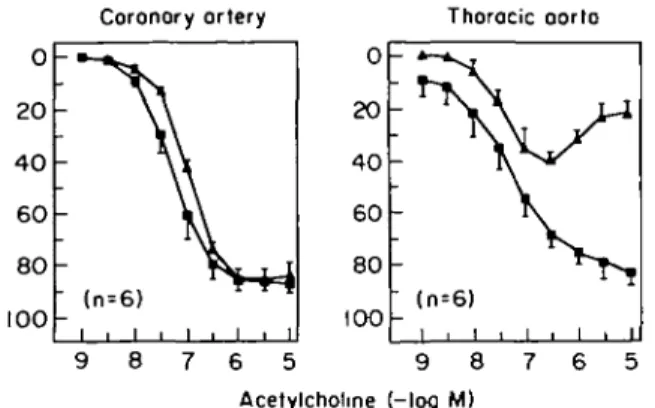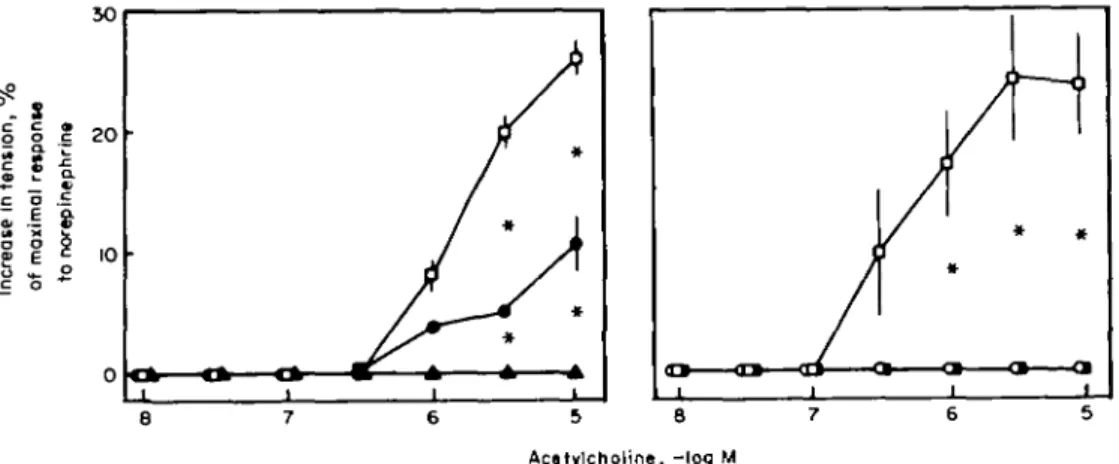European Heart Journal (1992) 13 {Supplement D), 50-55
Heterogeneity of endothelial dysfunction in hypertension
T. F. LUSCHER
Department of Medicine, Divisions of Clinical Pharmacology and Cardiology and Department of Research, Laboratory of Vascular Research University Hospital, Basel, Switzerland
< i
KEY WORDS: Antihypertensive therapy, endothelin-1, mechanisms, heterogeneity, nitric oxide.
The endothelium may play a role as a target and mediator of hypertension. Due to its anatomical position, it is very exposed to mechanical forces; as a source of vasoactive material it may participate in increasing peripheral vascular resistance and in promoting local ischaemia in the heart and brain. Morphological and functional changes in the endothelium occur in experimental and human hypertension. However, the severity of the defect and the mechanisms involved among vascular beds and models of hypertension are heterogeneous. Endothelium-dependent relaxations are unpaired in theaorta, carotid artery and in cerebral and mesenteric arterioles in hypertension. In the coronary circulation the defect is less pronounced. The mechanisms involve a reduced formation of nitric oxide, an enhanced production of prostaglandin H2 .and an impaired responsiveness of vascular smooth muscle to nitric oxide. The role of endothelin in
hypertension is controversial; circulating levels appear unaltered except in the presence of renal failure or athero-sclerosis. The local vascular production of endothelin, however, may still be increased. The potentiating effects of threshold concentrations of endothelin on the vasoconstrictor response to noradrenalin are enhanced in hypertension.
Thus, subtle and distinct endothelial function defects occur in hypertension, but not all vascular beds are similarly affected and different mechanisms contribute. Endothelial dysfunction may contribute to increased peripheral resistance, tissue ischaemia and cardiovascular complications.
i
IntroductionHypertension is characterized by altered haemodynamic balance, in particular increased peripheral vascular resistance, as well as increased incidence of cardiovas-cular complications, such as myocardial infarction and stroke. The vasculature contributes both as a regulator of peripheral vascular resistance and as a target of high blood pressure. The latter alterations induced by hyper-tensive disease in certain vascular beds is a crucial event in the development of myocardial infarction and stroke. The primary structure of the blood vessel wall, which is most exposed to high blood pressure and hence develops early morphological and functional alterations, is the endothelium. The discovery that endothelial cells also secrete potent vasoactive substances1'"31 which appear to play an important role in the local regulation of vascular tone such as nitric oxide'4", prostacyclin'61, endothelin"1 and cyclooxygenase-derived contracting factors'7' further supports the concept that the endothelial organ may play an important role in hypertension both as a mediator and target of the disease.
Eadotbelinm-derived vasoactive mediators L-ARGININE/NITRIC OXIDE (NO) PATHWAY
In isolated blood vessels, the relaxation evoked by acetylcholine is abolished by removal of the endothelium and mediated by nitric oxide (NO) formed from L-argin-ine (Fig. I<'AO.81J J J ^ c n Zyr n C ( nitric oxide synthase, is calcium- and calmodulin-dependent. The release of NO Addreis for correspondence: T h o m u F. Uhcher, MD, Department of Medicine University Hoipitml, 4031 Bud/Switzerland.
0195-668X/92/0D0050 + 06 $08.00/0
can be triggered by shear stress (flow), the calcium iono-phore A23187, and a number of autocoids, including bradykinin, histamine, noradrenaline, substance P, vaso-pressin (in certain arteries), thrombin, and platelet-derived products (adenosine di- and triphosphate (ADP and ATP) and serotonin'1"9'). NO has a dual action and not only evokes relaxation of vascular smooth muscle, but also inhibits platelet adhesion and aggregation'101. Both effects require the activity of soluble guanylate cyclase, which leads to an increase in the intracellular levels of cyclic 3',5'-guanosine monophosphate (cGMP) (Fig. I'"1). The L-arginine pathway can be blocked by various N^-substituted derivatives of L-arginine, such as L-N°-monomethyl arginine, L-N°-nitroarginine methyl ester, or L-N-iminoethyl ornithine, which compete with the precursor of NO'5*1.
PROSTACYCLIN (PGI2)
Endothelial cells are a rich source of PGI2 which relaxes coronary arteries, increases coronary flow, and inhibits platelet aggregation'*1. The mechanism of action of PGI2 involves an increase in cyclic 3',5'-adenosine monophosphate (cAMP). The production of PGI2 is stimulated by shear stress, hypoxia, and autacoids, which release EDRF. However, PGI2 contributes very little to endothelium-dependent relaxations'2-81.
ENDOTHELJUM-DERIVED HYPERPOLARIZING FACTOR (EDHF)
In addition to NO, the endothelium releases a hyper-polarizing factor, at least in certain blood vessels. In canine coronary arteries, acetylcholine causes an endo-thelium-dependent hyperpolarization of smooth muscle cells that is mediated by a diffusible substance'121. © 1992 The European Society or Cardiology
•"-« \
Libsig
Voscular smooth muscle cell
Figure 1 The endothelial L-arginine nitric oxide (NO) pathway: NO is formed from L-arginine via the activity of NO synthase, a calcium- and calm-odulin-dependent enzyme which can be inhibited by analogues of L-arginine such as L-L-N°-monomethyl arginine ( L - N M M A ) . sGC = soluble guanylate cyclase, cGMP = cyclycGMP. Reproduced with permission'2'.
Similarly, in porcine coronary arteries, L - N M M A blocks the response to serotonin but not that to bradykinin'13'. Debate continues, however, whether at least under cer-tain conditions, NO or nitrovasodilators can hyperpolar-ize smooth muscle cells'14'. The endothelium-dependent hyperpolarization may contibute to the relaxation and/or reduce the sensitivity of vascular smooth cells of vasoconstrictor substances.
ENDOTHELIN
Endothelial cells also produce the potent vasoconstric-tor peptide, endothelin (Fig. 2'3'). The 21-amino-acid peptide is produced and released by endothelial cells (on the basis of de novo protein synthesis rather than release of stored peptide) upon stimulation with thrombin, transforming growth factor-beta, norepinephrine, phor-bol ester, and the calcium ionophore A23187 (Fig. 2 "-3'3 1). Three isoforms exist: endothelin-1, endothelin 2, and endothelin 3. Endothelial cells appear to produce primarily endothelin-1. In vascular smooth muscle, endothelin-1 binds to specific receptors, activates phos-pholipase, increases intracellular calcium and causes long-lasting contractions for renin'16'. The peptide has a greater vasoconstrictor potency than the other cardio-vascular hormones. In vivo, the circulating levels of the peptide are extremely low. Threshold concentrations, however, potentiate contractions evoked by norepine-phrine and serotonin (Fig. 31'71). In most, but not in all preparations, NO or nitrovasodilators are able to inhibit contractions induced by endothelin-11'8191. ln addition, EDRF or nitrovasodilators inhibit the release of endo-thelin from intact porcine aorta'15'.
CYCLOOXYGENASE-DEPENDENT CONTRACTING FACTORS
In certain blood vessels, endothelium-dependent increases in tension can be obtained with arachidonic acid, acetylcholine, serotonin and other agonists (see'1'16'). Most of these responses can be prevented by cyclooxygenase inhibitors, such as indomethacin or meclofenamate, suggesting that they are mediated by a cyclooxygenase-dependent contracting factor (Fig. 2). Depending on the blood vessels and agonists studied, the responses also can be prevented by thromboxane synthetase inhibitors, thromboxane receptor antagonists or scavengers of oxygen-derived free radicals. These pharmacological data support the notion that the cyclooxygenase pathway can produce mediators causing endothelium-dependent contractions such as thrombo-xane A2, prostaglandin H2 or superoxide anions'16'.
Although a distinct endothelium-derived contracting factor released during hypoxia has been proposed, more recent evidence strongly suggests that endothelium-dependent contractions to hypoxia are due to removal of nitric oxide (the production of which is oxygen-depen-dent) rather than due to the release of contractile material1201.
Heterogeneity of endothelial dysfunction in hypertension In isolated arteries obtained from hypertensive animals with different forms of hypertension, alterations of endothelial function have been documented by numerous groups'1'. Similarly, in human hypertension endothelial dysfunction occurs'21'22'. However, in
52 T. F. Luscher AA.PGIs Renm AI AH TGFg AVP Thr.
i I i I
Smooth muscle cells A23I87 Ach NE 5-HT ADPI I I !
Stretch ADP Ach Bk
1 I 1
I
1
Figure 2 Endothelium-dependent contractions: The endothelium is a source of numerous contracting
factors such as endothelin-1 (ET), thromboxane A2 (TXAi), prostaglandin H2 (PGH2) and possibly also
of angiotensin II (All). The cyclooxygenase pathway is also a source of superoxide anions (O2) which is
able to break down nitric oxide (NO). O = receptors; AA = arachidonic acid; ACE = angiotensin converting enzyme; Ach = acetylcholine; ATG = angiotensinogen; ADP = adenosine diphosphate; AVP = arginine vasopressin; Bk = bradylunin; 5HT = serotonin (5-hydroxytryptamine); NE = norepinephrine; PGF-beta = transforming growth factor beta; Thr = thrombin. Reproduced with permission from the American Heart Association"".
experimental hypertension, it appears that endothelial dysfunction is particularly prominent in certain, but not in all, vascular beds and in addition may be related to different mechanisms in different vascular beds as well as in different models of hypertension.
ANATOMICAL HETEROGENEITY
Most studies have been performed in large conduit arteries, such as the aorta, where reduced endothelium-dependent relaxations have been described in all rat models of hypertension. Similarly, in the carotid as well as the cerebral microcirculation, impaired endothelium-dependent relaxations or vasodilatation respectively have been documented in the spontaneously hyperten-sive rat (Fig. 4123>24)). Similarly, endothelium-dependent relaxations are impaired in the mesenteric resistance circulation'231. In contrast, although endothelium-depen-dent contractions occur in the spontaneously hyperten-sive rat in the renal circulation, the responses differ very little from those obtained in normotensive Wistar Kyoto rats, at least up to an age of 30 weeks123'. In isolated epicardial coronary arteries of the spontaneously hyper-tensive rat, endothelium-dependent relaxations do not differ from those obtained in Wistar Kyoto rats up to an age of 60 weeks (Fig. 41261). Hence, although altered endothelium-dependent responses occur in experimental hypertension of the rat, certain vascular beds, in particu-lar particu-large coronary and renal arteries, appear to be pro-tected from the defect, while in other arteries marked endothelium dysfunction can be noted.
HETEROGENEITY OF SPECIES
Endothelial function has been investigated in experi-mental hypertension of the rat, rabbit and mouse as well as in human essential hypertension1'1. In all rat models of hypertension, impaired endothelium-dependent relax-ations have been observed, while in the rabbit (which does develop less pronounced hypertension) very little
Figure 3 Potentiating effects of low and threshold concentrations
of endothelin-1 (ET) in the human internal mammary artery. In the presence of minute amounts of ET, the response to nore-pinephrine is enhanced, an effect which is prevented by the dihydro-piridine calcium antagonist PY (darodipine). Reproduced with permission from the American Heart Association117'.
Coronory ortery 0 20 40 60 80 00 Thoracic -i -i -i -i -i aorta 1 1 1 1 6 5 9 8 7 6 5 Acetylcholme (-log M)
Figure 4 Heterogeneity of endothelial dysfunction in experimental
hypertension. In the thoracic aorta of the spontaneously hyperten-sive rat ( A ) , endothelium-dependent relaxations to acetylcholine are markedly reduced as compared to normotensive Wistar-Kycto rats ( • ) (right panel), while in the coronary artery of the same animals, the responses are well maintained (left panel). Data repro-duced from17-231.
alteration has been noted'27' and in psychosocial hyper-tension in the mouse an enhanced response to endo-thelium-dependent agonists has even been reported'28'. In the human forearm circulation of patients with essen-tial hypertension, two independent research groups have reported impaired endothelium-dependent vasodilation to acetylcholine with a preserved or only slightly altered responsiveness to sodium nitroprusside (Fig. 5l2ia2]).
HETEROGENEITY OF MECHANISMS
An alteration in endothelium-dependent regulation of vascular tone can involve the endothelial vasodilator as well as vasoconstrictor systems. In the case of endo-thelium-dependent relaxations, a reduced response could involve a specific defect in all or certain receptor-opera-ted pathways, an impaired production of nitric oxide
0-08 0-6 Sodium nitroprusside (Mg.minH-l0°m|~'' •0 40 Acetylcholine 160
Figure 5 Impaired endothelium-dependent vasodilation in human
essential hypertension. Infusion of acetylcholine in the brachial artery causes marked decreases in forearm vascular resistance, an effect which is impaired in hypertensives ( B ; n - 8 ) as compared to normotensives ( • ; n = 8). * P=< 0 0 5 . Reproduced with per-mission from the American Heart Association121'.
from L-arginine, a reduced smooth muscle responsive-ness to the endogenous nitrovasodilator and/or a con-comitant formation of a contracting factor interfering with the effects of NO.
All of these disturbances have been observed under certain conditions, but are not uniformly found in all models of hypertension or all vascular beds studies. Although an increased medial thickness commonly occurs in hypertensive arteries, both in conduit vessels as well as in the resistance circulation, a reduced respon-siveness to NO donors such as sodium nitroprusside or SIN-1 is particularly prominent in the aorta and the carotid artery of the hypertensive rat'23'29', while in mes-enteric resistance arteries and in large renal arteries the response to the nitrovasodilators is well maintained'30'. Even in the presence of an impaired responsiveness to NO, this alteration does not fully explain the reduced endothelium-dependent relaxations, as the response to acetylcholine commonly is much more impaired than that to nitrovasodilators'30'. Hence, different endothelial mechanisms must be altered under these conditions.
In the spontaneously hypertensive rat, endothelium-dependent relaxations are impaired to certain but not all agonists, although all of them activate specific receptors linked to the formation of relaxing factors'1'. Indeed, in the aorta of these animals, the response of acetylcholine is markedly reduced, while that to thrombin is fully maintained and that to histamine may actually be enhanced'17'. This suggests that defects may be quite specific and must not necessarily involve all pathways activating endothelial cells.
In mesenteric resistance arteries of the spontaneously hypertensive and 2-kidney-l clip renovascular hyperten-sion, the relaxations to acetylcholine are impaired although that to endothelium-independent vasodilators such as SIN-1 are normal, suggesting a reduced forma-tion ofendothelium-derivedNO'2330'31'. In perfused mes-enteric resistance arteries, intraluminal activation of the endothelium by acetylcholine is particularly impaired in hypertension, while extraluminal application of acetylcholine evokes normal responses'23'. This suggests that the intraluminal surface of the endothelium, which is most exposed to high blood pressure, selectively exhib-its the defect.
In the aorta of the spontaneously hypertensive rat, but not in that of the Dahl salt-induced hypertensive rat, acetylcholine causes endothelium-dependent contrac-tions mediated by prostaglandin H2 (Fig. 6'716'). In this preparation, antagonists of the thromboxane receptor or inhibitors of cyclooxygenase (which prevent the forma-tion of the vasoconstrictor prostanoids) can normalize the imparied endothelium-dependent relaxations to acetylcholine. Hence, in this particular preparation an increased formation of an endothelium-derived contract-ing factor derived from the cyclooxygenase pathway (i.e. prostaglandin H2) is responsible for the impaired relaxa-tions in response to acetylcholine, serotonin and aggre-gating platelets"61.
The contribution of endothelin in this context remains uncertain'"1. As judged from the circulating levels of the
54 T. F. Luscher °- S g g | ! c o I* X o o c o
I
Q . « o 50 2 0 10 0 A / ,y
if
/
/
/
y /
/^ *
•
*
8 7 6 5 8 7 6 Acatylcholine, -log MFigure 6 Endothelium-dependent contractors to acetykholine in the aorta of the spontaneously hypertensive rat. Acetylcholine elicits endothelium-dependent contractions at higher concentrations which are prevented by the phospholipase A2 quinacrine or the cyclooxygenase inhibitors indomethacin or meclofenomate.
* / ' < 0 0 5 . D = c o n t r o l ; • =quinacrine, 10~3M; A = quinacrine, 10~*M; O = indomethacin, 10"5M; • = meclofenamate, 10~5M. Reproduced with permission from the American Heart Association'71.
peptide in rat and human hypertension it appears that the production of endothelin is not grossly increased (for review see1'6') except in the presence of renal failure or atherosclerosis132'. However, circulating levels of endo-thelin may not necessarily reflect the local vascular pro-duction of the peptide, particularly since endothelin is preferentially released into the abluminal direction. In addition, the production of the peptide may be increased in certain but not all vascular beds. An interesting effect of endothelin in this context is the fact that the peptide, even at threshold concentrations, can potentiate the response to other vasoconstrictor hormones, suggesting that it may act as a regulator of vascular contractility (see Fig. 3). In ageing and hypertensive rats this indirect potentiating effect of threshold concentrations of endo-thelin are augmented133'34'. Angiotensin II expresses
A 0 12 34 .. •• w m m h ET MHC B 0 i 1 1 1 1 2 1 1 3 4 5 1 1 1 1 1 1 h ET MHC C 0 1 1 2 1 1 h ET MHC Control Angiotensin II
Figure 7 Stimulation of endothelin (ET) messenger RNA by angiotensin H in endothelial cells in culture obtained from the por-cine aorta (A), the rat aorta (B) or from freshly obtained endothel-ial cells of the mesenteric micTocirculation (C). The increase in message in the latter cells is quantified in panel D. Reproduced with permission from the American Heart Association'34'.
endothelin messenger RNA even in the microcirculation (Fig. 7134') and stimulation with All of perfused mesen-teric resistance arteries is associated with an endotheli-um-dependent potentiation of the response to norepinephrine (Fig. 8|34'). As this response is prevented by phosphoramidone, an inhibitor of the endothelin con-verting enzyme, as well as endothelin antibody, this strongly suggests that angiotensin II is able to stimulate local vascular endothelin production which then in turn augments contractile responses to noradrenaline. If this were to occur in vivo, such response may participate in the pressure effects of very low concentrations of angio-tensin II.
6-5 6 Norepinephrine (-logM)
5-5
Figure8 Potentiating effects of angiotensin II (All 10 M) in per-fused mesenteric resistance arteries with endothelium obtained from the spontaneously hypertensive rat. Perfusion of the vessels with All for 5 h increases the response to norepinephrine ( * />< 0 0 5 ; * * />< 0 0 1 ) . This endothelium-dependent potentiation
of the response to norepinephrine induced by All is prevented by either the endothelin converting enzyme inhibitor, phosphorami-done, or an endothelin antibody. D=control; • = A H ; E3 = All + phosphoraminadone; B3 = All + endothelin antibody (n = 5). Reproduced with permission from the American Heart Association'34'.
V
v> •
V
-. \
ENDOTHELIAL DYSFUNCTION AND BLOOD PRESSURE In the Dahl rat, the impairment of endothelium-dependent relaxations to acetylcholine correlates with the degree of blood pressure elevation'291. Antihyperten-sive therapy on the other hand, normalizes the response in Dahl salt-hypertensive rats'291. Similarly, in the spon-taneously hypertensive rat, endothelium-dependent relaxations to acetylcholine are impaired in the mesentric resistance circulation of adult (>16 weeks of age) but not of young spontaneously hypertensive rats (6 weeks of age'25'). As antihypertensive therapy with calcium antagonists or drugs interfering with the renin angioten-sin system both prevent this defect, it is likely that the impaired endothelium-dependent relaxations are a con-sequence, rather than a cause, of high blood pressure'251. The authors thank Bernadette Weber-Libsig and Amanda N. de Sola Pinto for technical assistance. Original research supported in this article was made possible by grants from the Swiss National Research Foundation (SCORE Grant 3231-025150, Project Grant 32-25468.88), The Helmut Horton Foundation, the Stanley Thomas Johnson Foundation and the Sandoz Foundation on Age Research.
References
[1] Luscher TF, Vanhoutte PM. The Endothelium: Modulator of Cardiovascular Function. Boca Raton, FL, CRC Press, 1990: 1-215.
[2] Furchgott RF, Zawadzki JV. The obligatory role of endo-thelial cells in the relaxation of arterial smooth muscle by acetylcholine. Nature 1980; 299: 373-6.
[3] Yanagisawa M, Kurihara H, Kimura S el al. A novel potent vasoconstrictor peptide produced by vascular endothelial cells. Nature 1988; 332: 411-15.
[4] Palmer RMJ, Ferrrige AG, Moncada S. Nitric oxide release accounts for the biological activity of endothelium-derived relaxaing factor. Nature 1987; 327: 524-6.
[5] Palmer RMJ, Ashton DS, Moncada S. Vascular endothelial cells synthesize NO from L-arginine. Nature 1988a; 333: 664-6.
[6] Moncada S, Vane JR. Pharmacology and endogenous roles of prostaglandin endoperoxides, thromboxane Ai and prosta-cydin. Pharmacol Rev 1979; 30: 293-31.
[7] Luscher TF, Vanhoutte PM. Endothelium-dependent con-tractions to acetylcholine in the aorta of the spontaneously hypertensive rat. Hypertension 1986; 8: 344-8.
[8] Yang Z, von Segesser L, Bauer E, Stulz P, Turina M, Luscher TF. Different activation of the endothelial L-arginine and cyclooxygenase pathway in the human internal mammary artery and saphenous vein. Circ Res 1991; 68: 52-60. [9] Yang Z, Stulz P, von Segesser L, Bauer E, Turina M, Luscher
TF. Different interactions of platelets with arterial and venous coronary bypass vessels. Lancet 1991; 337: 939-43. [10] Radomsky MW, Palmer RMJ, Moncada S. The
anti-aggre-gating properties of vascular endothelium: interactions between prostacyclin and nitric oxide. Br J Pharmacol 1987; 92:639-46.
[II] Rapoport RM, Murad F. Agonist-induced endothelium-dependent relaxation in rat thoracic aorta may be mediated through cGMP. Circ Res 1983; 52: 352-7.
[12] Feletou M, Vanhoutte PM. Endothelium-dependent hyper-polarization of canine coronary smooth muscle. Br J Pharmacol 1988; 93: 515-24.
[13] Richard V, Tanner FC, Tschudi M, Luscher TF. Differential activation of the endothelial L-arginine pathway by bradyki-nin, serotonin and clonidine in porcine coronary arteries. Am J Physiol 1990; 259: H1433-H1439.
[14] Tare M, Parkington HC, Coleman HA, Neild TO, Dusting GJ. Hyperpolarisation and relaxation of arterial smooth muscle caused by NO derived from the endothelium. Nature 1990; 346: 69-71.
[15] Boulanger C, Luscher TF. Release of endothelin from the porcine aorta: inhibition by endothelium-derived nitric oxide. J C1in Invest 1990; 85: 587-90.
[16] Luscher TF, Boulanger Ch, Dohi Y, Yang Z. Endothelium-derived contracting factors. Hypertension 1992; 19: 117-30. [17] Yang Z, Richard V, von Segesser L et al. Threshold
concen-trations of endothelin 1 portentiate contractions to norepi-nephrine and serotonin in human arteries: a new mechanism of vasospasm? Circulation 1990; 82: 188-95.
[18] Luscher TF, Yang, Z, Tschudi M et al. Interaction between endothelin-1 and endothelium-derived relaxing factor in human arteries and veins. Circ Res 1990; 66: 1088-94. [19] Kiowski W, Luscher TF, Linder L, Buhler TF. Endothelin-1
induced vasoconstriction in man: reversal by calcium channel blockade but not by nitrovasodilators or endothelium-derived relaxing factor. Circulation 1991; 83: 469.
[20] Graser T, Vanhoutte PM. Contractoin of canine coronary arteries to severe hypoxia: Role of endothelium, contraction level, and cyclic GMP. Am J Physiol (in press).
[21] Linder L, Kiowski W, Buhler Fr, Luscher TF. Indirect evi-dence for release of endothelium-derived relaxing factor in human forearm circulation in vivo: blunted response in essen-tial hypertension. Circulation 190; 81: 1762-7.
[22] Panza JA, Quyyumi AA, Brush JE, Epstein SE. Abnormal endothelium-dependent vascular relaxation in patients with essential hypertension. N EngI J Med 1990; 323: 22-7. [23] Luscher TF, Diederich D, Weber E, Vanhoutte PM, Buhler
FR. Endothelium-dependent responses in carotid and renal arteries of normotensive and hypertensive rats. Hypertension
1988; 11:573-8.
[24] Mayhan WG, Faraci FM, Heistad DD. Responses of cerebral arterioles to adenosine 5'-diphosphate, serotonin, and the thromboxane analogue U-46619 during chronic hypertension. Hypertension 1988; 12: 556-61.
[25] Dohi, Y, Thiel MA, Buhler FR, Luscher TF. Activation of endothelial L-arginine pathway in resistance arteries: Effect of Age and Hypertension. Hypertension 1990; 15: 170-9. [26] Tschudi MR, Criscione L, LQscher TF. Effect of ageing and
hypertension on endothelial function of rat coronary arteries. J Hypertension 1991; 9 (Suppl. 6): 164-5.
[27] Wright CE, Angus JA. Effects of hypertension and hyper-cholesteremia on vasodilatation in the rabbit. Hypertension 1986:8:361-71.
[28] Webb RC, Vander AJ, Henry JP. Increased vasodilator responses to acetylcholine in psychosocial hypertensive mice. Hypertension 1987; 9: 268-76.
[29] Luscher TF, Vanhoutte PM, Raij L. Antihypertensive treat-ment normalizes decreased endothelium-dependent relaxa-tions in rats with salt-induced hypertension. Hypertension
1987; 9 (Suppl III): IIII93-IIII97.
[30] Diederich D, Yang Z, Buhler FR, Luscher TF. Impaired endothelium-dependent relaxations in hypertensive resistance arteries involve the cyclooxygenase pathway. Am J Physiol 1990; 258: H445-H451.
[31] Dohi Y, Criscione L, Luscher TF. Renovascular hypertension impairs formation of endothelium-derived relaxing factors and sensitivity to endothelin-1 in resistance arteries. Br J Pharmacol 1991; 104: 349-54.
[32] Lerman A, Edwards BS, Hallett JW, Heublein DM, Sondberg SM, Burnett JC Jr. Circulating and tissue endothelin immuno-reactivity in advanced atherosclerosis. N EngI J Med 1991; 325:997-1001.
[33] Dohi Y, Luscher TF. Aging differentially affects direct and indirect actions of endothelin-1 in perfused mesenteric arteries of the rat. Br J Pharmacol 1990; 100: 889-93.
[34] Dohi Y, Hahn AWA, Boulanger Ch, Buscher TF. Endothelin stimulated by angiotensin II augments contractility of SHR resistance arteries. Hypertension 1992; 19: 131-7.



